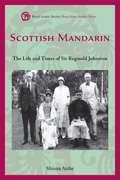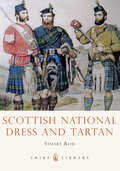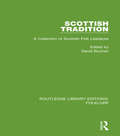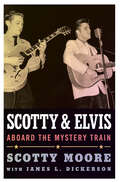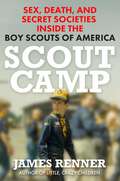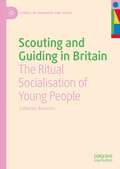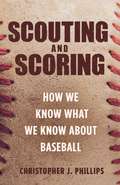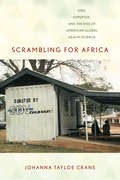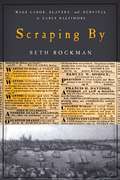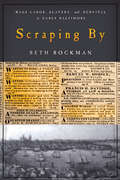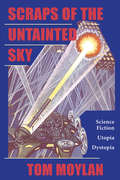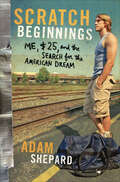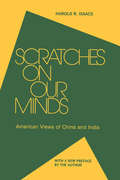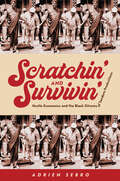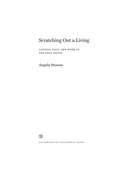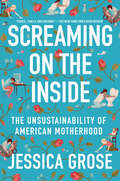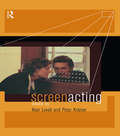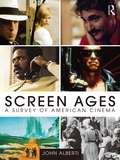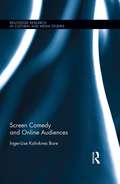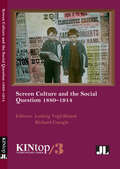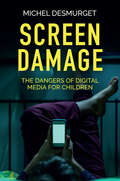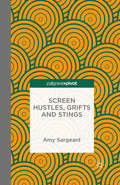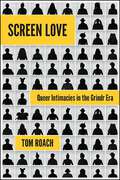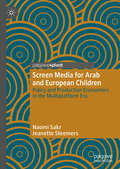- Table View
- List View
Scottish Mandarin
by Shiona AirlieColonial administrator, writer, explorer, Buddhist, and friend to China's last emperor, Sir Reginald Johnston (1874-1938) was a distinguished sinologist with a tangled love and family life that he kept secret even from his closest friends. Born and educated in Edinburgh, he began his career in the colony of Hong Kong and eventually became Commissioner of the remote British leased territory of Weihai in northern China. He travelled widely and, during a break from colonial service, served as tutor and advisor to Puyi, the deposed emperor. As the only foreigner allowed to work in the Forbidden City, he wrote the classic account of the last days of the Qing Dynasty--Twilight in the Forbidden City'.
Scottish National Dress and Tartan
by Stuart ReidTartan is an enormously popular pattern in modern fashion and Scottish National Dress is recognised around the world. This book reveals the origin and development of tartans and Scottish national costume. Beginning as Highland dress, it was originally peculiar to certain areas of Scotland but is now generally accepted as its national costume.What was once ordinary working clothing of a distinctive local style has been formalised and embellished to turn it into a ceremonial dress suitable for days of celebration, while tartans once woven according to the fancy of those who wore them, have also become fixed with certain patterns prescribed for different families, areas or institutions. This process was not, as is popularly thought, a phenomenon begun by the romantic novels of Sir Walter Scott, but began long before as a reaction to the Union with England in 1707. This book not only traces its evolution from earliest time, but the process by which it became Scottish National Dress.TOC: Chapter I: The Highland Clans /Chapter II: Early Highland Dress /Chapter III: Rebels and Kilts /Chapter IV: Invention of Scottish National Dress /Chapter V: Tartan - a national dress /Chapter VI Scottish National Dress today /Appendix: Major Tartans
Scottish Tradition: A Collection of Scottish Folk Literature (Routledge Library Editions: Folklore)
by David BuchanScottish folk literature is characterised by a wide range of creative expression: story, song, play and proverb. This anthology, first published in 1984, provides an authoritative introduction to Scottish folk literature, and is unique in that it deals with all the genres intrinsic to Scottish tradition. Its selected texts offer an unusual and diverse enjoyment to the reader, including such forms as wonder tales or Märhcen, classical ballads, riddles, jocular tales, lyric and comic and occupational folksongs, rhymes, historical and supernatural legends, and guisers’ plays. The texts chosen cover the main regional traditions of Lowland Scotland, from Galloway to the Shetlands, and span a number of centuries, through both pre- and post-industrial periods, from a sailor’s worksong of the sixteenth century to modern urban legends just recently recorded. The book is arranged in four sections, on Folk Narrative, Folksong, Folksay, and Folk Drama, each with an introduction and a bibliographical essay setting the material in context and indicating some of its international links. Folk literature itself is brought into firm focus by discussion and generic example, and the anthology as a whole illuminates substantial areas of Scottish social and cultural life.
Scotty and Elvis: Aboard the Mystery Train (American Made Music Series)
by Scotty MooreWhen Elvis Presley first showed up at Sam Phillips's Memphis-based Sun Records studio, he was a shy teenager in search of a sound. Phillips invited a local guitarist named Scotty Moore to stand in. Scotty listened carefully to the young singer and immediately realized that Elvis had something special. Along with bass player Bill Black, the trio recorded an old blues number called “That's All Right, Mama.” It turned out to be Elvis's first single and the defining record of his early style, with a trilling guitar hook that swirled country and blues together and minted a sound with unforgettable appeal. Its success launched a whirlwind of touring, radio appearances, and Elvis's first break into movies. Scotty was there every step of the way as both guitarist and manager, until Elvis's new manager, Colonel Tom Parker, pushed him out. Scotty and Elvis would not perform together again until the classic 1968 “comeback” television special. Scotty never saw Elvis after that. With both Bill Black and Elvis gone, Scotty Moore is the only one left to tell the story of how Elvis and Scotty transformed popular music and how Scotty created the sound that became a prototype for so many rock guitarists to follow. Thoroughly updated, this edition delivers guitarist Scotty Moore's story as never before.
Scout Camp: Sex, Death, and Secret Societies Inside the Boy Scouts of America
by James RennerIn this timely and deeply personal true crime memoir, acclaimed journalist, author, creator of the True Crime This Week podcast, and former Boy Scout James Renner, explores the dark side of an American institution, its pervasive culture of sexual abuse, and the traumatic—even deadly—repercussions of its long-buried secrets. In the summer of 1995, at the largest Boy Scout camp in Ohio, a night of sexual violence ended with one counselor dead and another hospitalized. The death was ruled &“accidental.&” It wouldn&’t be the last death associated with Seven Ranges Reservation. James Renner, too, was a counselor at Seven Ranges that year. He was always sure there must be more to the story of Mike Klingler&’s death, because Renner also knew firsthand that the 900-acre camp was not the safe getaway it was portrayed to be. On Friday nights the boys were ushered into the woods for a frightening ceremony in which they learned the rules for becoming good young men—and, above all, that keeping secrets was a Scout&’s duty. No matter how dark the secrets were. Determined to face his demons, Renner embarks on a journey back to that tumultuous summer and exposes a clandestine society that left indelible scars on the Scouts and the staff who were there. For Renner, it meant opening up about his twisted upbringing, his issues with trust and sexuality, and a lifetime of self-medication. The result is a deeply personal, no-holds-barred, and vitally important true crime memoir.
Scouting and Guiding in Britain: The Ritual Socialisation of Young People (Studies in Childhood and Youth)
by Catherine BannisterThis book explores the prevailing role of rites of passage, ritual, and ceremony in contemporary children’s lives through the lens of modern-day incarnations of uniformed youth movements. It focuses on the socialising ritual and customary practices of present-day grass-roots Scout and Guide groups, asking how Britain’s largest and best-known uniformed youth organisations employ ritualised activities to express their values to their young members through language and gesture, story and song, dress, and physical artifacts. The author shows that these practices exist against a backdrop of culturally-constructed beliefs about what constitutes the ‘good child’ and ‘good childhood’ in twenty-first century Britain, with in-movement practices intended to help children develop positively and prepare for social life. The book draws on case study accounts of group performances, incorporating the voices of children and adults reflecting on their practices and experiences.
Scouting and Scoring: How We Know What We Know about Baseball
by Christopher PhillipsAn in-depth look at the intersection of judgment and statistics in baseballScouting and scoring are considered fundamentally different ways of ascertaining value in baseball. Scouting seems to rely on experience and intuition, scoring on performance metrics and statistics. In Scouting and Scoring, Christopher Phillips rejects these simplistic divisions. He shows how both scouts and scorers rely on numbers, bureaucracy, trust, and human labor in order to make sound judgments about the value of baseball players.Tracing baseball’s story from the nineteenth century to today, Phillips explains that the sport was one of the earliest and most consequential fields for the introduction of numerical analysis. New technologies and methods of data collection were supposed to enable teams to quantify the drafting and managing of players—replacing scouting with scoring. But that’s not how things turned out. Over the decades, scouting and scoring started looking increasingly similar. Scouts expressed their judgments in highly formulaic ways, using numerical grades and scientific instruments to evaluate players. Scorers drew on moral judgments, depended on human labor to maintain and correct data, and designed bureaucratic systems to make statistics appear reliable. From the invention of official scorers and Statcast to the creation of the Major League Scouting Bureau, the history of baseball reveals the inextricable connections between human expertise and data science.A unique consideration of the role of quantitative measurement and human judgment, Scouting and Scoring provides an entirely fresh understanding of baseball by showing what the sport reveals about reliable knowledge in the modern world.
Scrambling For Africa: AIDS, Expertise, and the Rise of American Global Health Science (Expertise: Cultures and Technologies of Knowledge)
by Johanna Tayloe CraneCountries in sub-Saharan Africa were once dismissed by Western experts as being too poor and chaotic to benefit from the antiretroviral drugs that transformed the AIDS epidemic in the United States and Europe. Today, however, the region is courted by some of the most prestigious research universities in the world as they search for resource-poor hospitals in which to base their international HIV research and global health programs. In Scrambling for Africa, Johanna Tayloe Crane reveals how, in the space of merely a decade, Africa went from being a continent largely excluded from advancements in HIV medicine to an area of central concern and knowledge production within the increasingly popular field of global health science. Drawing on research conducted in the U. S. and Uganda during the mid-2000s, Crane provides a fascinating ethnographic account of the transnational flow of knowledge, politics, and research money as well as blood samples, viruses, and drugs. She takes readers to underfunded Ugandan HIV clinics as well as to laboratories and conference rooms in wealthy American cities like San Francisco and Seattle where American and Ugandan experts struggle to forge shared knowledge about the AIDS epidemic. The resulting uncomfortable mix of preventable suffering, humanitarian sentiment, and scientific ambition shows how global health research partnerships may paradoxically benefit from the very inequalities they aspire to redress. A work of outstanding interdisciplinary scholarship, Scrambling for Africa will be of interest to audiences in anthropology, science and technology studies, African studies, and the medical humanities.
Scraping By: Wage Labor, Slavery, and Survival in Early Baltimore
by Seth RockmanEnslaved mariners, white seamstresses, Irish dockhands, free black domestic servants, and native-born street sweepers all navigated the low-end labor market in post-Revolutionary Baltimore. Seth Rockman considers this diverse workforce, exploring how race, sex, nativity, and legal status determined the economic opportunities and vulnerabilities of working families in the early republic. In the era of Frederick Douglass, Baltimore's distinctive economy featured many slaves who earned wages and white workers who performed backbreaking labor. By focusing his study on this boomtown, Rockman reassesses the roles of race and region and rewrites the history of class and capitalism in the United States during this time. Rockman describes the material experiences of low-wage workers—how they found work, translated labor into food, fuel, and rent, and navigated underground economies and social welfare systems. He also explores what happened if they failed to find work or lost their jobs. Rockman argues that the American working class emerged from the everyday struggles of these low-wage workers. Their labor was indispensable to the early republic’s market revolution, and it was central to the transformation of the United States into the wealthiest society in the Western world. Rockman’s research includes construction site payrolls, employment advertisements, almshouse records, court petitions, and the nation’s first "living wage" campaign. These rich accounts of day laborers and domestic servants illuminate the history of early republic capitalism and its consequences for working families.
Scraping By: Wage Labor, Slavery, and Survival in Early Baltimore (Studies in Early American Economy and Society from the Library Company of Philadelphia)
by Seth RockmanCo-winner, 2010 Merle Curti Award, Organization of American HistoriansWinner, 2010 Philip Taft Labor History Book Award, ILR School at Cornell University and the Labor and Working-Class History AssociationWinner, 2010 H. L. Mitchell Award, Southern Historical AssociationEnslaved mariners, white seamstresses, Irish dockhands, free black domestic servants, and native-born street sweepers all navigated the low-end labor market in post-Revolutionary Baltimore. Seth Rockman considers this diverse workforce, exploring how race, sex, nativity, and legal status determined the economic opportunities and vulnerabilities of working families in the early republic.In the era of Frederick Douglass, Baltimore's distinctive economy featured many slaves who earned wages and white workers who performed backbreaking labor. By focusing his study on this boomtown, Rockman reassesses the roles of race and region and rewrites the history of class and capitalism in the United States during this time. Rockman describes the material experiences of low-wage workers—how they found work, translated labor into food, fuel, and rent, and navigated underground economies and social welfare systems. He also explores what happened if they failed to find work or lost their jobs. Rockman argues that the American working class emerged from the everyday struggles of these low-wage workers. Their labor was indispensable to the early republic’s market revolution, and it was central to the transformation of the United States into the wealthiest society in the Western world. Rockman’s research includes construction site payrolls, employment advertisements, almshouse records, court petitions, and the nation’s first "living wage" campaign. These rich accounts of day laborers and domestic servants illuminate the history of early republic capitalism and its consequences for working families.
Scraps Of The Untainted Sky: Science Fiction, Utopia, Dystopia
by Thomas MoylanDystopian narrative is a product of the social ferment of the twentieth century. A hundred years of war, famine, disease, state terror, genocide, ecocide, and the depletion of humanity through the buying and selling of everyday life provided fertile ground for this fictive underside of the utopian imagination. From the classical works by E. M. Forster, Yevgeny Zamyatin, Aldous Huxley, George Orwell, and Margaret Atwood, through the new maps of hell in postwar science fiction, and most recently in the dystopian turn of the 1980s and 1990s, this narrative machine has produced challenging cognitive maps of the given historical situation by way of imaginary societies which are even worse than those that lie outside their authors' and readers' doors.In Scraps of the Untainted Sky , Tom Moylan offers a thorough investigation of the history and aesthetics of dystopia. To situate his study, Moylan sets out the methodological paradigm that developed within the interdisciplinary fields of science fiction studies and utopian studies as they grow out of the oppositional political culture of the 1960 and 1970s (the context that produced the project of cultural studies itself). He then presents a thorough account of the textual structure and formal operations of the dystopian text. From there, he focuses on the new science-fictional dystopias that emerged in the context of the economic, political, and cultural convulsions of the 1980s and 1990s, and he examines in detail three of these new "critical dystopias:" Kim Stanley Robinson's The Gold Coast, Octavia Butler's The Parable of the Sower , and Marge Piercy's He, She, and It .With its detailed, documented, and yet accessible presentation, Scraps of the Untainted Sky will be of interest to established scholars as well as students and general readers who are seeking an in-depth introduction to this important area of cultural production.
Scratch Beginnings: Me, $25, and the Search for the American Dream
by Adam W. ShepardA young man sets out to prove the American Dream is alive and well in this memoir of homelessness, grit, and perseverance.After reading Barbara Ehrenreich's influential book, Nickel and Dimed, Adam Shepard felt discouraged by its hopeless view of American opportunity. He set out to disprove Ehrenreich's theory—the notion that those who start at the bottom stay at the bottom—by making something out of nothing to achieve the American Dream.Shepard's plan was simple. With a sleeping bag, the clothes on his back, and $25 in cash, and restricted from using his contacts or college education, he headed out for Charleston, South Carolina, a randomly selected city with one objective: to work his way out of homelessness and into a life that would give him the opportunity for success. His goal was to have, after one year, $2,500, a working automobile, and a furnished apartment.Scratch Beginnings is a personal account of Shepard's struggle to overcome the pressures placed on the homeless. His story will not only inspire readers but will also remind them that success can come to anyone who is willing to work hard—and that America is still one of the most hopeful countries in the world.
Scratches on Our Minds: American Images of China and India
by Harold R. IsaacsA presentation of eight contemporary Chinese women writers, representing two generations of women with different backgrounds and experiences. The selections explore esthetic, cultural and ideological problems that continue to challenge Chinese women.
Scratchin' and Survivin': Hustle Economics and the Black Sitcoms of Tandem Productions
by Adrien SebroThe 1970s was a golden age for representations of African American life on TV sitcoms: Sanford & Son, Good Times, The Jeffersons. Surprisingly, nearly all the decade’s notable Black sitcoms were made by a single company, Tandem Productions. Founded by two white men, the successful team behind All in the Family, writer Norman Lear and director Bud Yorkin, Tandem gave unprecedented opportunities to Black actors, writers, and producers to break into the television industry. However, these Black auteurs also struggled to get the economic privileges and creative autonomy regularly granted to their white counterparts. Scratchin’ and Survivin’ discovers surprising parallels between the behind-the-scenes drama at Tandem and the plotlines that aired on their sitcoms, as both real and fictional African Americans devised various strategies for getting their fair share out of systems prone to exploiting their labor. The media scholar Adrien Sebro describes these tactics as a form of “hustle economics,” and he pays special attention to the ways that Black women—including actresses like LaWanda Page, Isabel Sanford, and Esther Rolle—had to hustle for recognition. Exploring Tandem’s complex legacy, including its hit racially mixed sitcom Diff’rent Strokes, he showcases the Black talent whose creative agency and labor resilience helped to transform the television industry.
Scratching Out a Living
by Angela StuesseHow has Latino immigration transformed the South? In what ways is the presence of these newcomers complicating efforts to organize for workplace justice? Scratching Out a Living takes readers deep into Mississippi's chicken processing plants and communities, where large numbers of Latin American migrants were recruited in the mid-1990s to labor alongside an established African American workforce in some of the most dangerous and lowest-paid jobs in the country. As America's voracious appetite for chicken has grown, so has the industry's reliance on immigrant workers, whose structural position makes them particularly vulnerable to exploitation. Based on the author's six years of collaboration with a local workers' center, this book explores how Black, white, and new Latino Mississippians have lived and understood these transformations. Activist anthropologist Angela Stuesse argues that people's racial identifications and relationships to the poultry industry prove vital to their interpretations of the changes they are experiencing. Illuminating connections between the area's long history of racial inequality, the industry's growth and drive to lower labor costs, immigrants' contested place in contemporary social relations, and workers' prospects for political mobilization, Scratching Out a Living paints a compelling ethnographic portrait of neoliberal globalization and calls for organizing strategies that bring diverse working communities together in mutual construction of a more just future.
Scream At The Sky
by Carlton StowersCarlton Stowers, the two-time Edgar Award winner and New York Times bestselling master of true crime, is back. Scream at the Sky is his masterful chronicle of one man's murderous career, and another man's sworn promise to deliver justice and closure to the people of Texas. Wichita Falls, Texas, was home to a hundred thousand people in the last months of 1984. That winter was harsh, as the normally arid Texas plains gave way to ominous dark clouds that delivered freezing sleet and rain. But a much darker force was looming, and soon the quiet town was besieged by a faceless evil-and its young women were dying because of it. In the next seventeen months five women were found brutally beaten and murdered, their young lives cut short and their bodies left haphazardly where they fell. In the years that followed, grieving families fruitlessly sought answers. A haunted district attorney chased every lead only to meet one dead end after another. And the killer's identity remained unknown to the ravaged townspeople. Then, fourteen years after the killing started, an investigator who had been assigned the cold case brought to it a renewed dedication, and came upon a chance discovery. Searching through the yellowed case files, he caught a minor detail that suggested one more suspect. Faryion Wardrip was an unhappily married family man who drowned his anger in substance abuse and violent fantasies. But for five unfortunate families, the drugs sometimes took over and the fantasies became realities. Investigator John Little followed his instincts and tirelessly ruled out every possibility until he was left with but one conclusion: Faryion Wardrip was the serial killer who had eluded his office for so long. How he tracked down Wardrip and used the legal system to beat the killer at his own game of deception is a remarkable story of justice served.
Screaming on the Inside: The Unsustainability of American Motherhood
by Jessica Grose"If this book feels like it’s sounding the alarm on the state of American motherhood, well, that’s because it is." -- San Francisco ChronicleIn this timely and necessary book, New York Times opinion writer Jessica Grose dismantles two hundred years of unrealistic parenting expectations and empowers today’s mothers to make choices that actually serve themselves, their children, and their communitiesClose your eyes and picture the perfect mother. She is usually blonde and thin. Her roots are never showing and she installed that gleaming kitchen backsplash herself (watch her TikTok for DIY tips). She seamlessly melds work, wellness and home; and during the depths of the pandemic, she also ran remote school and woke up at 5 a.m. to meditate.You may read this and think it’s bananas; you have probably internalized much of it.Journalist Jessica Grose sure had. After she failed to meet every one of her own expectations for her first pregnancy, she devoted her career to revealing how morally bankrupt so many of these ideas and pressures are. Now, in Screaming on the Inside, Grose weaves together her personal journey with scientific, historical, and contemporary reporting to be the voice for American parents she wishes she’d had a decade ago.The truth is that parenting cannot follow a recipe; there’s no foolproof set of rules that will result in a perfectly adjusted child. Every parent has different values, and we will have different ideas about how to pass those values along to our children. What successful parenting has in common, regardless of culture or community, is close observation of the kind of unique humans our children are. In thoughtful and revelatory chapters about pregnancy, identity, work, social media, and the crisis of the Covid-19 pandemic, Grose explains how we got to this moment, why the current state of expectations on mothers is wholly unsustainable, and how we can move towards something better.
Screen Acting
by Alan Lovell Peter KrämerWhile not everyone would agree with Alfred Hitchcock's notorious remark that 'actors are cattle', there is little understanding of the work film actors do. Yet audience enthusiasm for, or dislike of, actors and their style of performance is a crucial part of the film-going experience. Screen Acting discusses the development of film acting, from the stylisation of the silent era, through the naturalism of Lee Strasberg's 'Method', to Mike Leigh's use of improvisation.The contributors to this innovative volume explore the philosophies which have influenced acting in the movies and analyse the styles and techniques of individual filmmakers and performers, including Bette Davis, James Mason, Susan Sarandon and Morgan Freeman. There are also interviews with working actors: Ian Richardson discusses the relationship between theatre, film and television acting; Claire Rushbrook and Ron Cook discuss theri work with Mike Leigh, and Helen Shaver discusses her work with the critic Susan Knobloch.
Screen Ages: A Survey of American Cinema
by John AlbertiScreen Ages is a valuable guide for students exploring the complex and vibrant history of US cinema and showing how this film culture has grown, changed and developed. Covering key periods from across American cinema history, John Alberti explores the social, technological and political forces that have shaped cinematic output and the varied impacts cinema of on US society. Each chapter has a series of illuminating key features, including: ‘Now Playing’, focusing on films as cinematic events, from The Birth of a Nation to Gone with the Wind to Titanic, to place the reader in the social context of those viewing the films for the first time ‘In Development’, exploring changing genres, from the melodrama to the contemporary super hero movies, ‘The Names Above and Below the Title’, portraying the impact and legacy of central figures, including Florence Lawrence, Orson Welles and Wes Anderson Case studies, analyzing key elements of films in more depth Glossary terms featured throughout the text, to aid non-specialist students and expand the readers understanding of changing screen cultures. Screen Ages illustrates how the history of US cinema has always been and continues to be one of multiple screens, audiences, venues, and markets. It is an essential text for all those wanting to understand of power of American cinema throughout history and the challenges for its future. The book is also supported by a companion website, featuring additional case studies, an interactive blog, a quiz bank for each chapter and an online chapter, ‘Screen Ages Today’ that will be updated to discuss the latest developments in American cinema.
Screen Comedy and Online Audiences (Routledge Research in Cultural and Media Studies)
by Inger-Lise Kalviknes BoreThe question of why we laugh (or don't laugh) has intrigued scholars since antiquity. This book contributes to that debate by exploring how we evaluate screen comedy. What kinds of criteria do we use to judge films and TV shows that are meant to be funny? And what might that have to do with our social and cultural backgrounds, or with wider cultural ideas about film, TV, comedy, quality and entertainment? The book examines these questions through a study of audience responses posted to online facilities such as Twitter, Facebook, review sites, blogs and message boards. Bore’s analysis of these responses considers a broad range of issues, including how audiences perceive the idea of "national" comedy; what they think of female comedians; how they evaluate romcoms, sitcoms and web comedy; what they think is acceptable to joke about; what comedy fans get excited about; how fans interact with star comedians; and what comedy viewers really despise. The book demonstrates some of the ways in which we can adapt theories of humour and comedy to examine the practices of contemporary screen audiences, while offering new insights into how they negotiate the opportunities and constrictions of different online facilities to share their views and experiences.
Screen Culture and the Social Question, 1880–1914 (KINtop #3)
by Ludwig Vogl-Bienek and Richard CrangleEssays exploring how reformers and charities used the “magic lantern” to raise public awareness of poverty.Public performances using the magic or optical lantern became a prominent part of the social fabric of the late nineteenth century. Drawing on a rich variety of primary sources, Screen Culture and the Social Question, 1880-1914 investigates how the magic lantern and cinematograph, used at public lectures, church services, and electoral campaigns, became agents of social change.The essays examine how social reformers and charitable organizations used the “art of projection” to raise public awareness of the living conditions of the poor and the destitute, as they argued for reform and encouraged audiences to work to better their lot and that of others.
Screen Damage: The Dangers of Digital Media for Children
by Michel DesmurgetAll forms of recreational digital consumption – whether on smartphones, tablets, game consoles or TVs – have skyrocketed in the younger generations. From the age of 2, children in the West clock up more than 2.5 hours of screen time a day; by the time they reach 13, it&’s more than 7 hours a day. Added up over the first 18 years of life, this is the equivalent of almost 30 school years, or 15 years of full-time employment. Most media experts do not seem overly concerned about this situation: children are adaptable, they say, they are &‘digital natives&’, their brains have changed and screens make them smarter. But other specialists – including some paediatricians, psychiatrists, teachers and speech therapists – dispute these claims, and many parents worry about the long-term consequences of their children&’s intensive exposure to screens. Michel Desmurget, a leading neuroscientist, has carefully weighed up the scientific evidence concerning the impact of the digital activities of our children and adolescents, and his assessment does not make for happy reading: he shows that these activities have significant detrimental consequences in terms of the health, behaviour and intellectual abilities of young people, and strongly affect their academic outcomes. A wake-up call for anyone concerned about the long-term impacts of our children&’s over-exposure to screens.
Screen Hustles, Grifts and Stings: Stings, Grifts, Hustles and the Long Con
by A. SargeantScreen Hustles, Grifts and Stings identifies recurrent themes and techniques of the con film, suggests precedents in literature and discusses the perennial appeal of the con man for readers and viewers alike. Core studies span from film (Catch Me If You Can, Paper Moon, House of Games) to television (Hustle), from Noir (The Grifters) to Romantic Comedy (Gambit). Frequently, the execution of the con is only finely distinguishable from the conduct of a legitimate profession and, challengingly, a mark is often shown to be culpable in his or her undoing. The best con films, it is suggested, invite re-watching and reward the viewer accordingly: who is complicit and when? How and where is the con achieved? When is the viewer party to the con? And what, if any, moral is to be drawn?
Screen Love: Queer Intimacies in the Grindr Era
by Tom RoachIn work, play, education, and even healthcare, we are using social media during COVID-19 to approximate "normal life" before the pandemic. In Screen Love, Tom Roach urges us to do the opposite. Rather than highlight the ways that social media might help reproduce the pre-pandemic status quo, Roach explores how Grindr and other dating/hookup apps can help us envision a radically new normal: specifically, antinormative conceptions of selfhood and community. Although these media are steeped in neoliberal relational and communicative norms, they offer opportunities to reconceive subjectivity and ethics in ways that defy normative psychological and sexual paradigms. In the virtual cruise, Roach argues, we might experience a queer sociability in which participants are formally interchangeable avatar-objects. On Grindr and other m4m platforms, a model of selfhood championed in liberal-humanist traditions—an intelligent, altruistic, eloquent, and emotionally expressive self—is often a liability. By teasing out the queer ethical and political potential of an antisocial, virtual fungibility, Roach compels readers to think twice about media typically dismissed as sordid, superficial, and narcissistic. Written for students, professors, and nonacademics alike, Screen Love is an accessible, provocative, and at times subversively funny read.
Screen Media for Arab and European Children: Policy and Production Encounters in the Multiplatform Era
by Jeanette Steemers Naomi SakrThis book addresses gaps in our understanding of processes that underpin the making and circulation of children's screen contents across the Arab region and Europe. Taking account of recent disruptive shifts in geopolitics that call for new thinking about how children’s media policy and production should proceed after large-scale forced migration in both regions, the book asks to what extent children in Europe and the Arab World are engaging with the same content. Who is funding new content and who is making it, according to whose criteria? Whose voices are loudest when it comes to pressures for regulation of children’s screen content, and what exactly do they want? The answers to these questions matter for anyone seeking insights into diverse cross-cultural collaborations and content innovations that are shaping new investment and production relationships.
